Amongst the matters about which the Wahhabis are most sensitive is the matter of renovation of graves and construction over the graves of Prophets, Imams and the pious ones.
This matter was at first initiated by Ibn Taymiyya and his famous student Ibn al-Qayyim and they gave their verdicts (fatawa) in prohibiting the construction of a structure and the necessity of its destruction.
Ibn al-Qayyim in his book Zad al-ma’ad fi huda khayr al-‘ibad says as such:
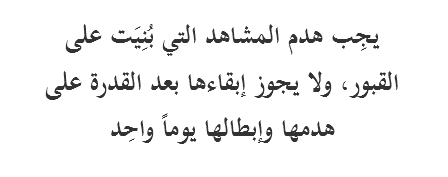
“It is obligatory to destroy the structure constructed over the grave and after gaining power for their destruction it is not permissible to reinstate them even for one day.”
Ibn Taymiyya (1263–1328), one of the most famous medieval Islamic jurists and theologians, whose influence is still palpable in current Sunni discourse. Ibn Taymiyya spent a large portion of his life in prison for his teachings; his last imprisonment was caused by his issuance of a legal opinion reportedly denouncing the visitation of the Prophet’s grave.
Ibn Taymiyya was defeated by his opponents, the ulama of Egypt and Syria, and died in prison together with his legal opinions condemning grave visitation and the belief in intercession. Despite his failure to prevail in his lifetime, however, Ibn Taymiyya left an influential legacy for subsequent generations—who, in the following centuries, still felt impelled to engage in similar debate, whether in refutation of his arguments or in defense of them. His spiritual legacy, perhaps oversimplified and whether justifiably or not, found a fertile ground in the person of Ibn ‘Abd al-Wahhab and has also been appropriated by today’s Salafis.
In the year 1344 AH when the Sa’uds had gained control over Mecca, Medina and its surroundings, they planned a pretext for destroying the graves of Baqi’ and the traces of household and companions of the Holy Prophet (s). By getting verdict (fatwa) from the scholars of Medina they wanted to pave the way for demolition and preparing the minds of the people of Hijaz who were never in favour of such action.
For this reason they sent the Chief Judge of Najd, Sulayman bin Bulayhid towards Medina for the purpose of deriving benefit from the scholars of that place regarding this matter. Thus he planned the questions in such a manner that its answers (as per the viewpoint of the Wahhabis) were hidden in the questions itself. And in this way he declared to the muftis that their replies should match the answers which had come in the questions; otherwise they would be called as polytheists and be killed if they would not repent.
Incidentally, after taking the verdict from fifteen scholars of Medina and publishing it in Hijaz, the destruction of the traces of the household of the Prophet (s) began on the 8th of Shawwal of the same year.
Sulayman bin Bulayhid says in his questions:

“What are the views of the scholars of Medina who, may God increase their knowledge and insight, about construction over the graves and setting them as mosques? Is it permissible or not? And if it is not permissible, and is strictly prohibited in Islam, then is it necessary and compulsory to destroy them and prevent the people from reciting prayers near it or not?”
If in one endowed (waqf) land like Baqi’ construction over the grave becomes an obstacle from making use of those sections which are over that, then is this act not usurpation of a portion of the waqf?
The scholars of Medina under threat and compulsion gave replies to the questions of Shaykh as follows:

Construction over the graves is forbidden. Based on some traditions proving its prohibition, a group have given verdict (fatwa) for the destruction of the same. In this matter they have made use of the tradition which Abu al-Hayyaj has narrated from ‘Ali (r). The latter told him – I am entrusting you with a work which the Messenger of God (s) had entrusted me with the same. Don’t see any picture but that you erase it and don’t see any grave but that you level it.
Shaykh Najdi in an article, which was published in the newspaper Umm al-Qura No. Jamadi al-thani 1345 AH, says:
Construction of dome and structure was in vogue from 5th century AH.
These are a few examples of the sayings of Wahhabis about renovation of graves and mostly they put forth two reasons in support of their sayings:
1. Consensus of the scholars of Islam about its being prohibited.
2. Tradition of Abu al-Hayyaj from Ali (‘a) and some other similar ones.
It should be known that our discussion at present is about renovation of graves and construction of bower or ceiling over them. However the matter of ziyara – visitation to graves – will be discussed separately.
For making the matter clear, we will discuss this issue from three perspectives:
1. What is the view of the Qur’an regarding this matter? Can we derive the judgement from the Qur’an?
2. Does the Islamic ummah in reality have consensus in its being prohibited or is it that in all the Islamic ages the matter was something else and renovation of graves and construction of house was in vogue during the period of the Holy Prophet (s) himself and his companions?
3. What is the derivation of the tradition of Abu al-Hayyaj, Jabir, Umm Salama and Na’im which the Wahhabis utilise?
The First Destruction of Baqi’ Cemetery
From 1205 AH to 1217 AH, the Wahhabis made several attempts to gain a foothold in Hijaz but failed. Finally, in 1217 AH, they somehow emerged victorious in Taif where they spilled the innocent blood of Muslims. In 1218 AH, they entered Makkah and destroyed all sacred places and domes there, including the one which served as a canopy over the well of Zamzam.
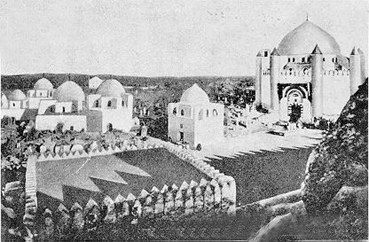
In 1221, the Wahhabis entered Madina to desecrate al-Baqi as well as every mosque they came across. An attempt was even made to demolish the Prophet’s tomb, but for one reason or another, the idea was abandoned. In subsequent years, Muslims from Iraq, Syria, and Egypt were refused entry into Makkah for Hajj. King Al-Saud set a precondition that those who wished to perform the pilgrimage would have to accept Wahhabism or else be branded as non-Muslims, becoming ineligible for entry into the Haram.
Al-Baqi was razed to the ground, with no sign of any grave or tomb whatsoever. But the Saudis were still not quite satisfied with doing all of that. Their king ordered three black attendants at the Prophet’s shrine to show him where the treasure of valuable gifts were stored. The Wahhabis plundered the treasure for their own use.
Thousands of Muslims fled Makkah and Madina in a bid to save their lives and escape from the mounting pressure and persecution at the hands of the Wahhabis. Muslims from all over the world denounced this Saudi savagery and exhorted the Caliphate of the Ottoman Empire to save the sacred shrines from total destruction.
Then, as it is known, Muhammad Ali Basha attacked Hijaz and, with the support of local tribes, managed to restore law and order in Madina and Makkah, dislodging the Al-Saud clansmen. The entire Muslim world celebrated this victory with great fanfare and rejoicing. In Cairo, the celebrations continued for five days. No doubt, the joy was due to the fact that pilgrims were once more allowed freely to go for Hajj, and the sacred shrines were once again restored.
In 1818 AD, the Ottaman Caliph Abdul Majid and his successors, Caliphs Abdul Hamid and Mohammed, carried out the reconstruction of all sacred places, restoring the Islamic heritage at all important sites. In 1848 and 1860 AD, further renovations were made at the expense of nearly seven hundred thousand pounds, most of which came from the donations collected at the Prophet’s tomb.
The Second Plunder by the Wahhabism
The Ottoman Empire had added to the splendor of Madina and Makkah by building religious structures of great beauty and architectural value. Richard Burton, who visited the holy shrines in 1853 AD disguised as an Afghan Muslim and adopting the Muslim name Abdullah, speaks of Madina boasting 55 mosques and holy shrines. Another English adventurer who visited Madina in 1877-1878 AD describes it as a small beautiful city resembling Istanbul. He writes about its white walls, golden slender minarets and green fields.
1924 AD Wahhabis entered Hijaz for a second time and carried out another merciless plunder and massacre. People in streets were killed. Houses were razed to the ground. Women and children too were not spared.
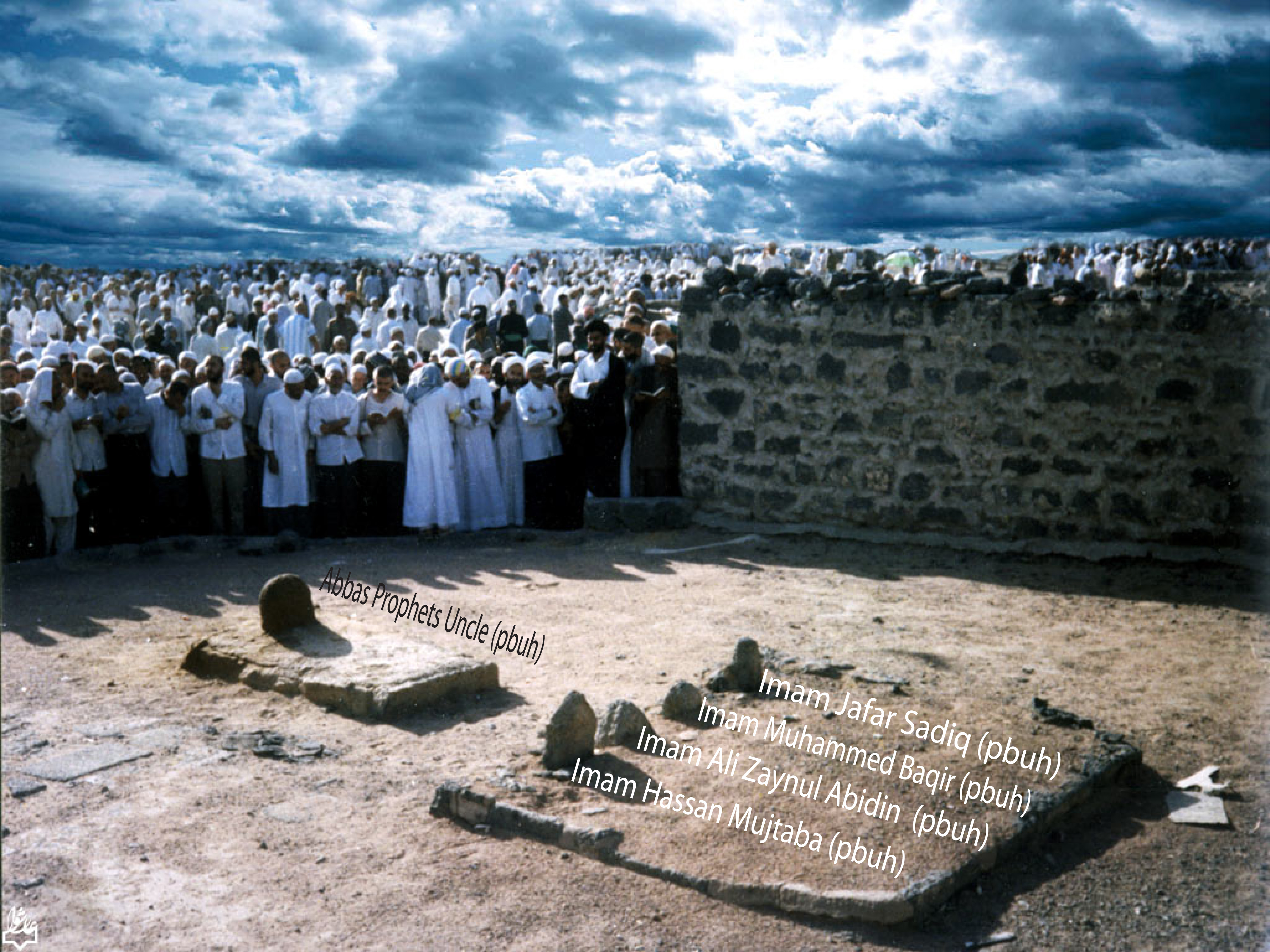
Awn bin Hashim (Shairf of Makkah) writes: “Before me, a valley appeared to have been paved with corpses, dried blood staining everywhere all around. There was hardly a tree which didn’t have one or two dead bodies near its roots.”
1925 Madina surrendered to the Wahhabi onslaught. All Islamic heritage were destroyed. The only shrine that remained intact was that of the Holy Prophet (s).
Ibn Jabhan says: “We know that the tomb standing on the Prophet’s grave is against our principles, and to have his grave in a mosque is an abominable sin.”
Tombs of Hamza and other martyrs were demolished at Uhud. The Prophet’s mosque was bombarded. On protest by Muslims, assurances were given by Ibn Saud that it will be restored but the promise was never fulfilled. A promise was given that Hijaz will have an Islamic multinational government. This was also abandoned.
1925 AD Jannat Al-Mu’alla, the sacred cemetery at Makkah was destroyed along with the house where the Holy Prophet (s) was born. Since then, this day is a day of mourning for all Muslims.
Is it not strange that the Wahhabis find it offensive to have the tombs, shrines and other places of importance preserved, while the remains of their Saudi kings are being guarded at the expense of millions of dollars?
Contemporary Destruction of Graves
Probably the largest incident of graves destruction in the contemporary Middle East occurred in Yemen. In September 1994, approximately two thousand men, armed with rocket-propelled grenades, explosives, and shovels, demolished the cemetery built around the shrine of a local Sufi saint in Aden. Not only was his sanctuary destroyed along with some elaborate wooden decor, but many graves were exhumed and their remains burnt.
This event was not the result of a mere rampage; it was a well-prepared and systematic action. (A bulldozer had even been brought along to level the graves.) The violent attack, clearly inspired by the practice of ziyara and rooted in disagreement over basic issues connected with grave culture, set off further incidents of grave destruction elsewhere in Yemen.
ISIS and Destroying the Graves
The ideology of the Islamic State of Iraq and the Levant (ISIL, also known as Daesh), which controls territory primarily in Iraq and Syria, has been described as being based on Salafism, Salafi Jihadism, and also on Islamism and Wahhabism.
Important doctrines of ISIL include its belief that it represents the restoration of the caliphate of early Islam, and that all Muslims are required to pledge allegiance to it; that a “defiled” Islam must be purged of apostasy, often with bloody sectarian killings, that the final Day of Judgment by God is near and will follow the defeat of the army of “Rome” by ISIL; that a strict adherence to following the precepts “established by the Prophet Muhammad and his earliest followers” is necessary, surpassing even that of other Salafi groups.
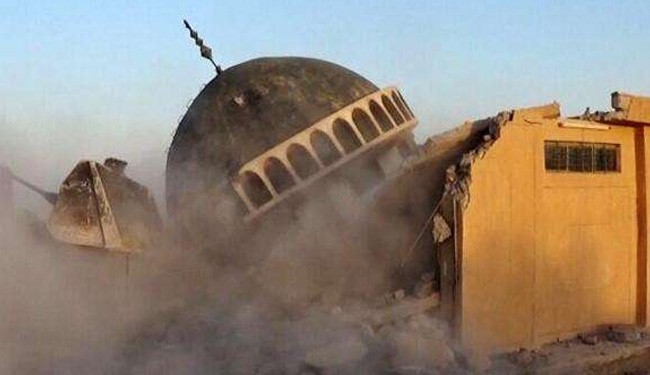
ISIL considers worshipping at graves tantamount to idolatry, and seeks to purify the community of unbelievers. It has used bulldozers to crush buildings and archaeological sites. Bernard Haykel has described al-Baghdadi’s creed as “a kind of untamed Wahhabism”, saying, “For Al Qaeda, violence is a means to an ends; for ISIS, it is an end in itself”.

The destruction by ISIL in July 2014 of the tomb and shrine of the prophet Yunus—Jonah in Christianity—the 13th-century mosque of Imam Yahya Abu al-Qassimin, the 14th-century shrine of prophet Jerjis—St George to Christians—and the attempted destruction of the Hadba minaret at the 12th-century Great Mosque of Al-Nuri have been described as “an unchecked outburst of extreme Wahhabism”.”
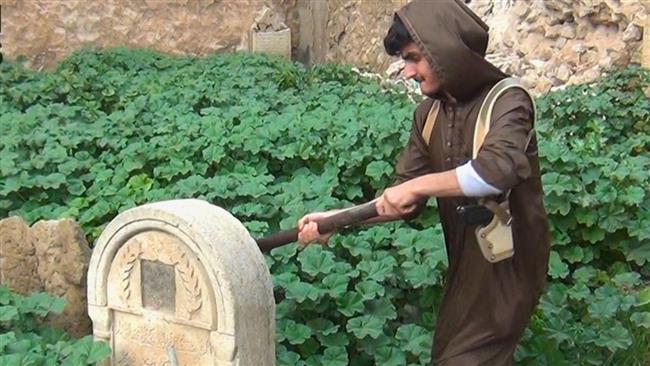
There were explosions that destroyed buildings dating back to the Assyrian era”, said National Museum of Iraq director Qais Rashid, referring to the destruction of the shrine of Yunus. He cited another case where “Daesh (ISIL) gathered over 1,500 manuscripts from convents and other holy places and burnt all of them in the middle of the city square”. In March 2015, ISIL reportedly bulldozed the 13th-century BC Assyrian city of Nimrud, believing its sculptures to be idolatrous.
A Plan to Demolish the Tomb of Prophet of Islam
In February 18, 2016 news reported that a controversial plan has emerged in Saudi Arabia to demolish the tomb of Islam’s Prophet Mohammad (PBUH) and relocate his body to an anonymous grave, in a move sure to draw an angry response from the Muslim world.
Nigerian army Following the Wahhabism Ideology bulldozes grave of Ayatollah Zakzaky’s mother
The Nigerian army has destroyed the burial place of prominent religious scholar Ayatollah Sheikh Ibrahim Zakzaky’s mother.
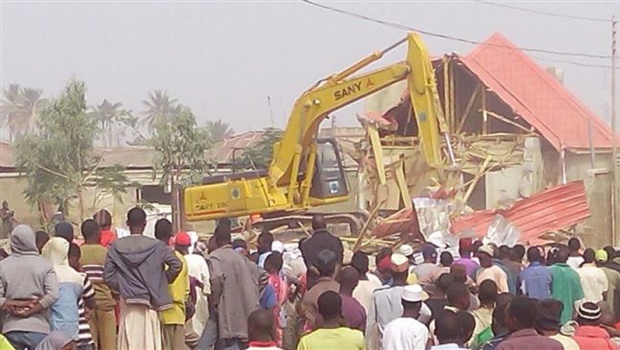
Condemnation by Muslim Scholars of Grave Destroying
Prominent Muslim clerics from Muslim countries such as Iran, Iraq, Egypt, Lebanon, Pakistan, India in issue number 20 of Open Letter to ISIS Leader stated that:
20. You have blown up and destroyed the graves of Prophets and Companions. Scholars disagree on the subject of graves. Nevertheless, it is not permissible to blow up the graves of Prophets and Companions and disinter their remains, just as it is not permissible to burn grapes under the pretext that some people use them to make wine. God says: ‘… Those who prevailed regarding their affair, “We will verily set up over them, a place of worship”.’ (Al-Kahf, 18:21); and: ‘… Take to yourselves Abraham’s station for a place of prayer …’ (Al-Baqarah, 2: 125). The Prophet said: ‘I had previously prohibited you from visiting graves. Permission has been granted for Muhammad to visit his mother’s grave, so visit them [i.e. graves] for they remind [one] of death and the Hereafter.’ Visiting graves reminds people of death and the Hereafter; God says in the Qur’an: ‘Rivalry [in worldly things] distracts you until you visit the graves.’ (AlTakathur, 102: 1-2).Your former leader, Abu Omar Al-Baghdadi said: ‘In our opinion, it is obligatory to destroy and remove all manifestations of shirk(idolatry) and to prohibit all means that lead to it because of Muslim’s narration in his Sahih: on the authority of Abu Al-Hiyaj Al-Asadi, ‘Ali ibn Abi Talib said: “Should I not tell you what he [i.e. the Prophet] sent me to do: not to leave a statue without obliterating it nor a raised grave without levelling it.”’ However, even if what he said were true, it does not apply to the graves of Prophets or Companions, as the Companions were in consensus regarding burying the Prophet and his two Companions, Abu Bakr and Omar, in a building that was contiguous to the Prophet’s Mosque.
The below are some Pictures and videos of Wahhabism destroying the Tombs:
Some pictures of Imam Hassan Askari’s (as) Holy Shrine after bombing by Wahhabi terrorism.
ISIL destroys part of Temple of Bel in Palmyra, Syria:Video
ISIL terrorists destroy ancient statues in Mosul museum:Video
 Ijtihad Network Being Wise and Faithful Muslim in the Contemporary World
Ijtihad Network Being Wise and Faithful Muslim in the Contemporary World
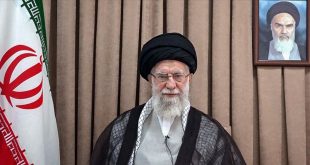
tnx for enlightening